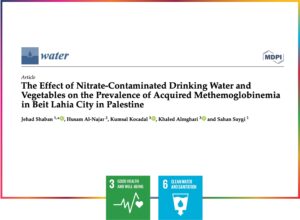
A collaborative study, with researchers Shaban, Kocadal and Saygı from Near East University, sheds light on the significant health and environmental implications of nitrate contamination in the north of the Gaza Strip. Nitrates, predominantly found in drinking water and vegetables, pose substantial risks to human health, particularly for infants.
The study, which analyzed 252 groundwater and drinking water samples along with 15 vegetable samples, revealed alarming levels of nitrate contamination. Groundwater samples exhibited concentrations ranging from 58.3 mg/L to 178.4 mg/L, with 97% exceeding WHO guidelines. Drinking water nitrate levels ranged from 10 to 17 mg/L, indicating widespread contamination. Among vegetables, zucchini displayed the highest nitrate content, with concentrations reaching 275.86 ± 58.87 mg kg−1.
Furthermore, analysis of 87 infant blood samples uncovered methemoglobinemia in 32.2% of cases, underscoring the health risks posed by nitrate exposure. Infants aged 6–12 months were particularly vulnerable due to contaminated drinking water and nitrate-rich vegetables.
In light of these findings, the study emphasizes the urgent need for proactive measures to address nitrate contamination and safeguard public health. Monitoring of desalination plants is recommended to ensure compliance with WHO guidelines, and efforts should be intensified to promote safe farming practices and reduce the use of nitrate-containing fertilizers.
The study’s conclusions underscore the critical importance of accurately assessing nitrate levels in water and food sources to mitigate health risks associated with nitrate exposure. By providing valuable insights into the extent of nitrate pollution and its impact on human health, the study serves as a vital resource for researchers and stakeholders striving to improve groundwater quality and mitigate the adverse effects of nitrate contamination.
Through collaborative efforts and proactive interventions, stakeholders can work towards minimizing nitrate pollution and protecting vulnerable populations from the harmful effects of nitrate exposure. This study’s findings serve as a foundation for informed decision-making and policy formulation aimed at addressing nitrate contamination and promoting public health in affected regions.
More Information:
https://www.mdpi.com/2073-4441/15/11/1989